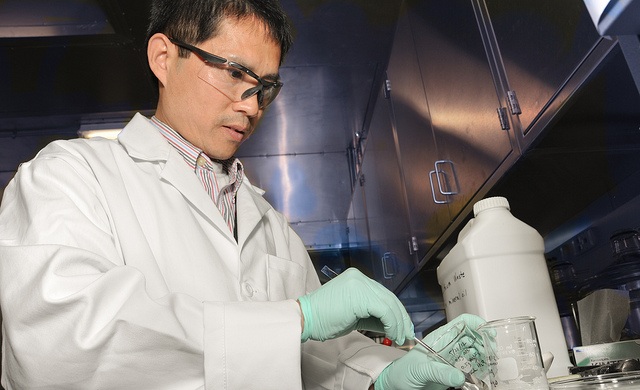While I am not personally a huge fan of high risk, high cost-of-capital businesses, I tend to spend a lot of time writing about them. Mining and high-tech are two of the highest cost-of-capital industries out there and, in my opinion, are only surpassed in risk to reward — assuming everything goes right -– by biotech/pharmaceuticals.

But, unlike gold mining, there is always a ton of cash floating around looking for a home. Since the current rally in stocks began in October 2011, biotech, as a sector, has outperformed all three major indices by a substantial margin with that out performance accelerating since the beginning of 2013.
This puts the majors in a very interesting position. The Shiller P/E of the S&P 500 (NYSEMKT:SPY) is currently 23.8. The iShares NASDAQ Biotechnology Index Fund (IBB) currently trades at an even richer multiple of 26.5. This ETF tracks the NBI and has returned more 27.4% year-to-date. With a number of major pharmaceuticals like Merck (NYSE:MRK) and Pfizer (NYSE:PFE) struggling with patent expiration, failure of promising replacements, and growth markets with far less respect for intellectual property than the U.S. and the E.U., it makes sense that we will see a rise in M&A activity while stocks continue to rise thanks to extremely accommodative monetary policy. Merck’s most recent earnings statements hit on all of these issues, but the company will be buying back $7.5 billion of its stock in the next 12 months.
This run on the S&P 500 has been nothing less than historic. Jeffery Saut of Raymond James, speaking with Eric King recently, noted that this current rally is nearly 3 months old without a significant pull back and yet there is still a tremendous short position above the market, which means we could easily see this rally continuing for another quarter or so. The chart seems to indicate it, certainly. This means that cash-rich companies that have been afraid to deploy capital as investments, but rather have been enhancing the liquidity-fueled rise in prices by buying-back their shares, will be in a position to get excellent value if and when they decide to buy up the most promising new technologies that more risk tolerant investors have guided through the early clinical trials.
Stocks are currently expensive but, given the current interest rate regime and overall structure of the market, they are poised to continue higher. We’re beginning to see sector rotation into high technology with major buying happening n companies like Intel (NYSE:INTC), Microsoft (NYSE:MSFT), and ARM Holdings (NYSE:ARMH).
So, given this background I am intrigued by the future of OncoSec Medical Inc (NASDAQOTH:ONCS) and ImmunoCellular Therapeutics Ltd (NASDAQOTH:IMUC). Both of these firms are focused on cancer research that target boosting of the immune system as a means to fight off the disease -– immunotherapy. While IMUC is focused squarely on the vaccine itself, ONCS is, at this point, focused on how the vaccine is delivered. Both companies have products in Phase 2 clinical trials with a high probability of data presentation by the end of the year.
Phase 2 results are an important hurdle, which marks the point where investor interest is truly piqued. Both companies have cash to see these trials through to their completion.
ONCS is interesting because of its delivery system, the OncoSec Medical System (OMS). Simply put, it bombards the surface of a malignancy with bursts of electricity (a process called electroporation) to perforate it temporarily and deliver a targeted dose of the treatment directly to the cancer cells while minimizing the dose taken up by healthy cells. This allows for treatment with as little as 5% of a normal dose, according to company claims, which greatly reduces the stress on the patient. Some treatments are too toxic at oral or intravenous dosages to administer and OMS could open them up as future options.
ONCS’s NeoPulse, which is ready for registration trials to begin in the E.U. for head, neck and skin cancers, delivers bleomycin, an approved, but very toxic drug for the treatment of a number of cancers, directly to a tumor, and has shown excellent results in destroying tumors without recurrence -– more than 8 months in European trials. While NeoPulse utilizes a direct attack approach to killing cancer cells, the administration of such a low dose greatly decreases poisoning of the patient and leaves him/her in far better shape to fight off the disease.
Cancer is an auto-immune disease that, like all such diseases, are best fought by the patient reducing stress and fortifying the immune system through not only direct treatment, but changes to diet and lifestyle.
ONCS’s other major technology, ImmunoPulse, uses the same OMS delivery system, but here it injects, according to the company, a plasmid DNA construct that builds the interleukin-12 (IL-12) cytokine to treat metastatic melanoma, Merkel cell, and cutaneous t-cell lymphomas. In short, the process is designed to boost the production of cytotoxic T-cells creating an increased auto-immune response to fight the cancer cells. It is the delivery system via electroporation that opens up this treatment option.
By focusing solely on skin cancer and lymphoma ONCS is setting itself up to prove that technology like OMS is applicable to a variety of cancer treatments. Moreover, the firm is targeting types of cancer that have very high mortality rates due to difficulty of treatment options available because of the inefficient delivery mechanisms of highly toxic chemotherapy drugs needed.
In essence, ONCS is killing two birds with one stone here, and by doing so opens itself up to receiving, I believe, serious attention from potential investors once the data from the Phase 2 trials currently underway are fully presented. In late March the firm reported initial data suggesting very strongly that the tumors treated have had ‘durable results.’
Looking over the company itself, it licensed technology from Inovio to build and continue development on what is now OMS. $1 million of the $3 million in licensing fees have been paid, mostly in stock according to the latest 10-K filing, with the rest of the money due in $1 million tranches this year. In December the firm had a successful capital raise and has nearly $9 million in cash to continue operations.
ONCS and IMUC — which is much farther along in the production and monetizing of its immunotherapies -– represent small-cap companies that have solutions with high long-term potential. OMS as a technology represents just one of the new ways that physical engineering can enhance bioengineering. Given the structure of the biotech market it makes sense that these are firms that could be swallowed up in the future.






